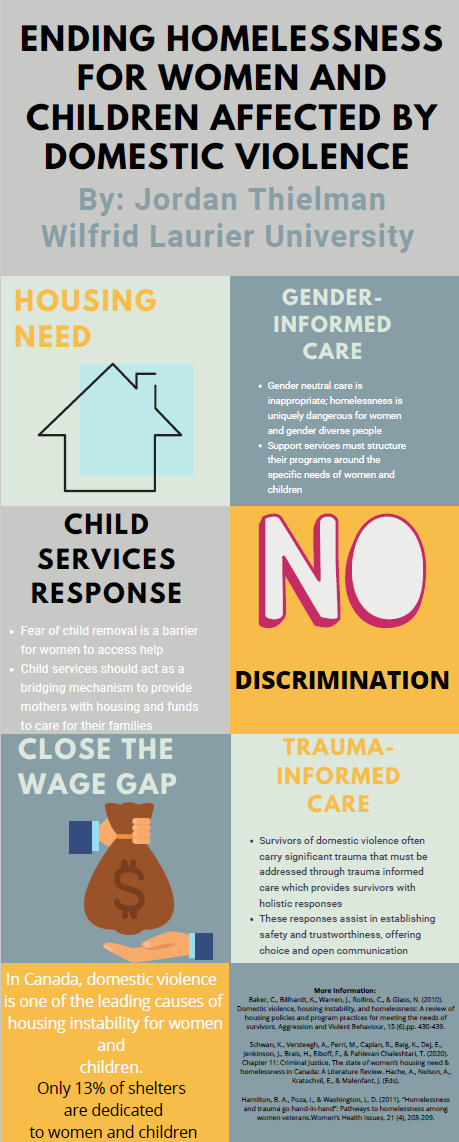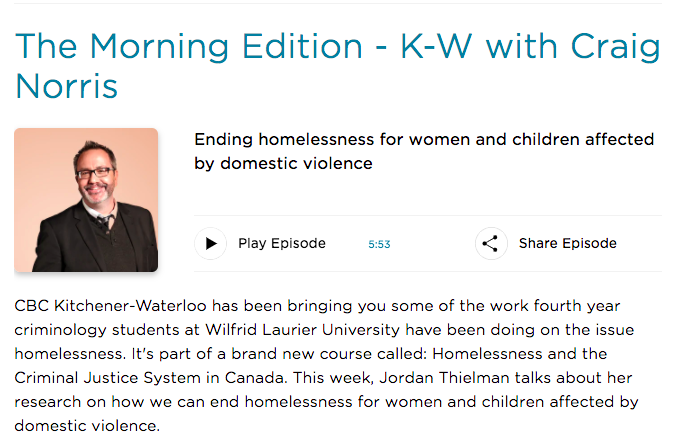In Canada, intimate partner violence is the leading cause of housing instability for women and children. Approximately 30% of Canada’s homeless population are women, 91% of whom have also endured some form of violence or assault in their lifetime. Organizations oriented towards women and gender-diverse people do not always have the geographic reach, resources, or capacity to provide adequate support to everyone who seeks out their services. This discrepancy between the need and the availability of resources perpetuates the cycle of violence and homelessness amongst this underserved group of people. Research continuously demonstrates homelessness as being uniquely dangerous for women. Discussions of women’s unique experiences of homelessness and housing precarity must be inclusive of women identifying and gender diverse people. Unfortunately, to date there is limited research on gender diverse people’s experiences, with notable exceptions.
The Facts
- 21% of single mothers in Canada raise their children in poverty
- Women often avoid shelters due to safety concerns
- Alternatively, women may stay in motels, with friends or family, couch surf or find partners to stay with
- 13% of all emergency shelters in Canada are dedicated to women
- Violence against women shelters are overwhelmed
- In 2017/2018, over 68,000 women and children stayed at violence against women shelters in Canada
- In 2018, on a single day 669 women and 236 accompanying children were denied shelter
- Every six days a woman in Canada is killed by her intimate partner
Key Challenges
Hidden Homelessness- The number of women and gender-diverse people experiencing homelessness in Canada is dramatically underestimated because they are less visible. The term commonly used to describe this is ‘hidden homeless’, whereby women find temporary shelter to avoid becoming absolutely homeless. For example, women might find themselves in high-risk situations in order to obtain shelter, such as violent relationships or by engaging in survival sex work. Other examples of hidden homelessness are couch surfing, living in a vehicle or staying in an overcrowded house. These living conditions are usually temporary and can increase the risk of instability and violence that women and their children may encounter. Many of the ways that we currently gather statistics about homelessness is unable to capture hidden homelessness. This means that many women and gender diverse people are left out of conversations about homelessness, as well as public policy and research agendas, thereby affecting funding priorities for necessary resources.
Shelter Barriers- As described above, only 13% of emergency shelters in Canada are dedicated to women. Although there are co-ed shelters, many women do not feel safe in these spaces, especially if they are survivors of violence. Not only is there a need for more shelter spaces for women, the resources within these buildings must be focused on the specific needs of women and gender diverse people.
Exiting Homelessness- For women who do access shelters, a major concern upon leaving the shelter system is what type of spaces they and their children will return to. In one study 21% of women staying in a shelter said they were returning to a residence where their abuser lived. The growing concern is that many women return to familiar violent households because the alternative is living on the streets and being at risk of violence at the hands of a stranger.
Hopeful Solutions
- Count Women Experiencing Homelessness
- Without an accurate assessment of the number of women and gender diverse people experiencing homelessness, it is difficult to implement sufficient and effective resources
- Without an accurate assessment of the number of women and gender diverse people experiencing homelessness, it is difficult to implement sufficient and effective resources
- Support Services Specifically Designed for Women and Gender Diverse People
- Programs that promote survivor autonomy and dignity are important for women who have experienced violence and trauma. Violence against women shelters should universally adopt a trauma-informed care approach which provides survivors with holistic responses to the unique challenges they may face
- Such programs will support women in their journey to escape the cycle of violence
- Advocate to child protection services for a more family-centered approach to women and their children who are at risk of, or are experiencing homelessness
- Fear of child removal is a major barrier for many women seeking shelter or other supports
- Child services can act as a bridging mechanism to provide caregivers with housing and necessary funding to care for their children
- Programs that promote survivor autonomy and dignity are important for women who have experienced violence and trauma. Violence against women shelters should universally adopt a trauma-informed care approach which provides survivors with holistic responses to the unique challenges they may face
- Redirect Funding Priorities
- Dedicate funding to create more women’s shelters and violence against women shelters across the country
- Develop additional programs to assist survivors of domestic violence in attaining safe and affordable long-term housing
- Communication Between Violence Against Women & Homelessness Systems
- Many of the current services treat intimate partner violence trauma and homelessness concerns as separate entities rather than intersecting issues
- Women’s experiences of homelessness and violence are not independent of one another
The systemic barriers to safe and affordable housing that exist today put women in dangerous and sometimes violent situations as a means to survive. This has created an undeniable link between the cycle of violence and precarious housing. Only when adequate government funding is made available to social service programs to support women, children, and gender-diverse people will we be able to provide services in a holistic and coordinated manner to meet their housing and safety needs. Therefore, investment in housing for women is ultimately investment in violence prevention.

The analysis and interpretations contained in this blog post are those of the individual contributors and do not necessarily represent the views of the Canadian Observatory on Homelessness.


